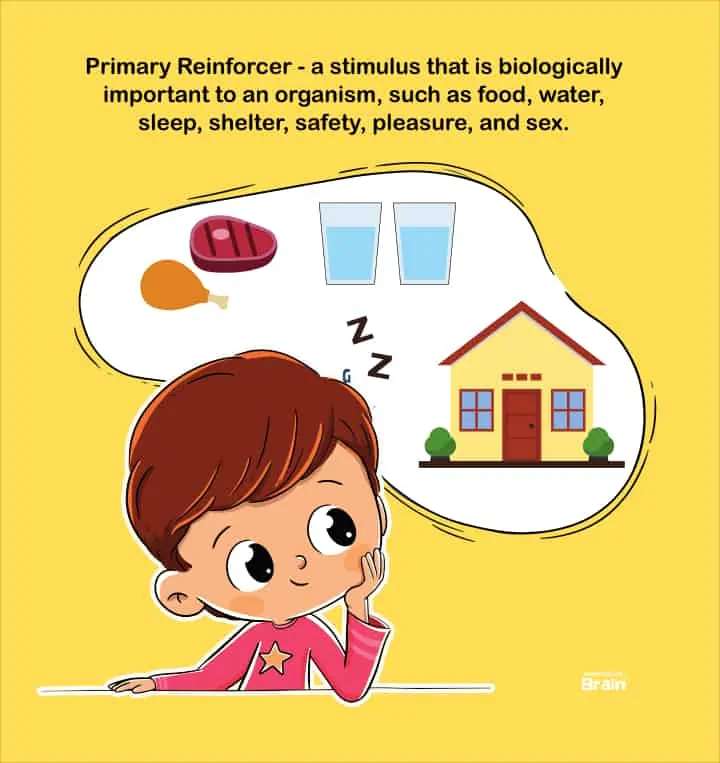The main difference between primary and secondary reinforcers is that the primary reinforcer is a biological stimulus causing involuntary reflexes while the secondary reinforcer is a conditioned stimulus causing learned behavior.
What are primary reinforcers and secondary reinforcers?
What is the difference when they are used in parenting?
How can parents and teachers make good use of it?
Let’s explore the psychology behind them and how parents and teachers can use them well.
TABLE OF CONTENTS
What is Primary Reinforcement
Primary reinforcement is a naturally occurring reaction to a stimulus. The response is innate and doesn’t require intricate learning. Primary reinforcement is an organism’s automatic reflex whenever the corresponding stimulus is presented1.
For instance, your mouth waters when you detect the delicious smell of your favorite food. It’s a natural reflex; you don’t need to learn to drool.
Most primary reinforcements result from evolution to ensure a species’ survival. Salivation in anticipation of food intake helps the body optimize digestion2.

What Is A Primary Reinforcer
A Primary Reinforcer is a biologically important stimulus to an organism, such as food, water, sleep, shelter, safety, pleasure, and sex. It leads to an involuntary response, such as recoiling, drooling, and trembling. In Classical conditioning theories, a primary reinforcer is also called an unconditioned reinforcer or unconditioned stimulus (UCS).
Although primary reinforcers are intrinsic drives that are naturally occurring, they may impact individuals differently depending on genetics and their experiences.
For example, some people can tolerate a higher temperature than others. When they touch something hot, their withdrawal reflex may not be triggered unless the object is scalding. The ability to withstand higher temperatures may be inborn or perhaps due to repeated encounters in the past, i.e., an individual may be trained by experience to react differently to a primary reinforcer.
Examples
1. Safety
When you touch a scorching iron, your hand recoils automatically to prevent burning, this reflex is a protective mechanism. The scalding touch is the primary reinforcer that reinforces automatic hand withdrawal.
2. Hunger
When a baby is hungry, she cries. Her caretaker then feeds her to satisfy her hunger. This response is a survival reflex that doesn’t require learning. In this case, hunger is the primary reinforcer that reinforces the crying.

Secondary Reinforcement and Secondary Reinforcer
Secondary reinforcement repeatedly pairs a neutral stimulus with a primary reinforcer so that the neutral stimulus can induce the same response as the primary one. Secondary reinforcement turns a neutral stimulus into a conditioned stimulus, also known as a secondary reinforcer.
So, what is the difference between primary and secondary reinforcers?
While a primary reinforcer is innate, a secondary reinforcer is a stimulus reinforcing after being paired with a primary reinforcer, such as praise, treats, or money. Responding to the secondary reinforcer is a learned behavior, not a born reflex.
Effectiveness and Durability
Primary reinforcements are effective because they are biological and fundamental to survival. They are often more effective than secondary reinforcers.
A hungry worker who is promised food to finish the work is more intrinsically motivated than someone working for free movie tickets.
Because primary reinforcements are essential for survival, they are hard to unlearn.
For example, it takes strong willpower or training not to scream when a heavy stone drops on your feet.
References
- 1.Clark RE. The classical origins of Pavlov’s conditioning. Integr psych behav. October 2004:279-294. doi:10.1007/bf02734167
- 2.Nederkoorn C, Smulders FTY, Jansen A. Cephalic phase responses, craving and food intake in normal subjects. Appetite. August 2000:45-55. doi:10.1006/appe.2000.0328
